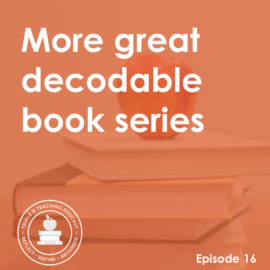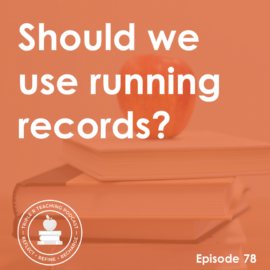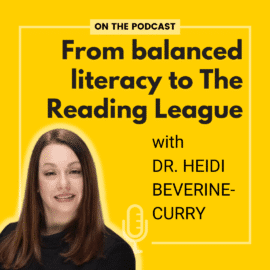
TRT Podcast#50: SOR Bootcamp #6 – How to structure the reading block in a science of reading classroom?
Now that we’ve laid a strong foundation, it’s time to apply the science of reading to your daily instruction. This episode will show you how to use what you’ve learned to schedule a powerful reading block that will meet the needs of all your students. Share this 6-week podcast series with friends who want to learn more about the science of reading.
Listen to the episode here
Full episode transcript
Hello, and welcome to Episode 50 of Triple R Teaching! This also happens to be the final episode in our science of reading bootcamp.
We've talked about the reasons why there's so much disagreement around the science of reading. We've talked about how we read and remember words. We went through some really important foundational pieces of the science of reading - the Simple View of Reading and Scarborough's Reading Rope. We talked about structured literacy and what the research tells us about phonological awareness, phonics, and so on.
Today is the day we're going to get very practical! We're going to talk about how you could set up your day as you're teaching reading - particularly in kindergarten, first, and second grade - when you have an understanding of the science of reading.
It starts by planning your schedule. Before we plan our schedule, we need to look at the big picture. One fair criticism of balanced literacy is that it tends to be focused more on the activities themselves than on the skills. We don't want that to happen.
Let's think about the Big Five which we talked about last week and how they fit into the Simple View of Reading. Remember that the Simple View of Reading is a mathematical formula that tells us that reading has two basic domains - word recognition and language comprehension. So when children can read individual words and comprehend language, reading comprehension can result. It's set up like a multiplication problem. Word recognition multiplied by language comprehension equals reading comprehension.
If you've got that picture in your mind, let's think about the Big Five and where they fit. Phonological and phonemic awareness and phonics all have to do with word recognition, so you could imagine those under the first domain. Vocabulary fits under language comprehension. Fluency doesn't actually fit under one of the domains. It's the automatic application of the two domains of word recognition and language comprehension. And reading comprehension? That's the product, right? That's the goal of reading!
We teach phonological awareness through phonological and phonemic awareness lessons. We teach phonics through phonics lessons. We teach vocabulary and reading comprehension through whole class interactive read alouds, and sometimes by reading grade level text together, particularly in second grade. We also do focus on comprehension as much as possible with the decodable books that children are reading. We build fluency by teaching students to decode words, giving them chances to do repeated reading and allowing them to read independently.
Our task now is to put all of these individual pieces into a daily schedule. In doing that, we're going to remember to include whole class lessons, small group lessons, and time for students to work independently. Now this could look one thousand different ways, and it's going to depend on so many things. I'm just going to give you one option.
What I would do is start with the whole class interactive read aloud that I've planned carefully. During that lesson, I'll be teaching vocabulary and comprehension.
Then I would move into a small group lesson. I know that there are some teachers that prefer to teach the whole phonics lesson to the whole class every day. Unless you HAVE to do that, I would not. Students are at SO many different levels and to me, that's a way to get kids not to love reading. You may be pushing them too fast because they're trying to keep up with the other kids in the whole group lesson, or boring them to tears doing phonics that they knew a year or two ago. So personally, I would assess all the students using a phonics assessment that includes both real and nonsense words, and then I would group them.
I prefer no more than four groups because it gets really hard to find time to teach more than that. That does mean, of course, that some kids will probably be put in a group a little bit lower than they actually are just to manage the total number of four groups, but I think that's okay, it's a much better option than having them learn with the whole class.
So you would plan these groups in advance and then after the whole class read aloud, you would have your students start their small group phonics lessons. You could do three or four small group phonics lessons per day. It probably would be best to do just three a day, because then you could have a good twenty minutes for each one. This leaves you a total of sixty minutes for kids to be meeting with you and for other kids to be doing centers. What that means is that your highest group is probably not going to meet with you EVERY day, but I'm sure that if they're very advanced, that's not going to be a problem.
While your students are meeting with you, your other students are doing MEANINGFUL literacy centers. These are not going to be things that are just keeping them busy, they're going to be things that improve their literacy skills. One thing to keep in mind about centers is that they are a really good place to be doing the cumulative practice, the review. Make sure that what you put at centers is something that your students already know and that they're reviewing versus new stuff. You want to make sure it's something they're confident in and can do on their own because they really benefit from that repeated practice.
If there's time, it would be great to put in another whole class interactive read aloud, especially if you're teaching really young kids.
Then you'll want to have some time in the day for fluency building and independent reading. Now, fluency building would be something that I would recommend for first grade and second grade, but not necessarily kindergarten. They're really too early in their reading journey to practice fluency. Independent reading for kindergarten probably wouldn't happen until later in the year because at the beginning of the year, they're just looking at pictures. That's fine, you could put that in a literacy center where they're just enjoying books, and there's a lot of benefit to that, but I wouldn't necessarily call that reading.
I have a blog post called "The Do's and Don'ts for Teaching Phonics," and in that blog post I go through a specific set of steps that are really important to have in a phonics lesson. I'll include that in the show notes so you can think more about how to plan your small group phonics lessons.
Let's talk a little bit about independent reading. That's become kind of a hot topic in the science of reading community because traditional independent reading time hasn't always been beneficial, especially for our low readers. One criticism of balanced literacy is that students spend too much time in independent reading. You might hear that and think, "How could that be a problem? Shouldn't students spend lots of time reading independently?"
Well, yes and no. Independent reading time is a problem when we think that students learn to read by reading. I thought that for a long time. While a tiny percentage of students can indeed teach themselves to read, most students need, and ALL students will benefit from, systematic sequential instruction in phonemic awareness, phonics, and other foundational skills. You know that!
When we leave them on their own for long periods of time, it's hard to make time for this important instruction. We don't want to have a forty five minute block of independent reading time because then where are we going to fit that explicit instruction?
It's also a problem when we don't give students any guidance in book choice. So if we say, "Okay, it's independent reading time, pick a book!" It can be questionable whether they're going to be able to read the book they choose, and if they're just looking at pictures, they're not growing as readers.
I know in the past, I assumed that because good readers read a lot, independent reading time will lead to better readers. But Tim Shanahan pointed out that correlation doesn't prove causation. Even if good readers read more, it doesn't mean it was reading more that made them good readers. It may be that good readers choose to read more because they can do it well.
Another problem with independent reading time is when we think that it will guarantee motivation to read. I know I have always held the belief that if students are given time to read, they'll learn to enjoy it and they'll become lifelong readers. The problem is that the motivational impact of independent reading time hasn't been studied very much.
Tim Shanahan also said, "In my experience, the better readers enjoy the free reading time so they continue to like reading, even within the independent reading time framework, but the other kids don't enjoy it much since they don't read very well."
The problem is that many struggling readers just pretend to read during independent reading time. They're not only NOT benefiting from this time, but they're actually losing instructional time that could be used to build the skills that would help them become successful readers.
I believe we should have independent reading time, but we have to come at it from a different angle. We should have it not because we want students to teach themselves to read, and not because we think that lots of independent reading time is going to increase motivation or help them become lifelong readers, that may result but there's no guarantee. No, we have independent reading time because students need to have practice reading and rereading texts to orthographically map the words! They need to have time to read independently so fluency, vocabulary, and comprehension can improve.
What I would do during this part of your day is to have each child have a large gallon plastic bag or some kind of book bin, and you would help them choose the books that would go in their bag. Personally, I would make sure that if you're doing decodable books with your students, kindergarten and first grade for sure, you would make certain that their bag has decodable books that they've already practiced. Or it could have new ones at their level for them to practice reading.
You could certainly have other books in there as well. If the child is enjoying a certain series of books and you know they do pretty well with them, you could include one of those. You could even have a "dessert" book, an extra book that they can "read" (even if they're not really reading it) after they've read their other books.
Use your best judgment about when to allow students to move out of decodable text for independent reading time. Once they have good beginning phonics knowledge and their strategy for reading is to look at the letters and sound out the words, not use pictures or context clues as a first line of attack, they might be ready for regular non-decodable books during independent reading time even if they can't read all the words.
You should also make sure that you have a system for letting students switch out the books in their bags, for instance maybe once a week you help students switch out books.
Ideally during independent reading time, you are moving around among the students and listening to them read and noticing who's ready for more books and who needs assistance.
That was all about independent reading, which is, I think something you need to include in your day. You've got one or two whole class interactive read alouds somewhere, you've got time for your focused phonics lessons while other students are doing review work at centers, and you have time for them to read independently, if they're at the right age for that - already reading at least decodable books.
You also want to think about fluency building. Some things you could do for fluency building include shared reading. You could have an enlarged book on a document camera on your screen, or a big book, or a poem that you read together and students can practice at least the prosody. Remember, prosody is when they read with expression, so that's a good time to practice things like that.
You can do partner reading with decodable books or other books that they can read together. You can do FORI, that's a whole class fluency building activity that you can look up. I've got information about that in my course, but that's something else you could try.
You can also include fluency at your centers. One of them could be buddy reading, and one of them could be having students play high frequency word games. You could also spend a week as a class doing reader's theater or partner plays during fifteen minutes. You can pass out scripts and assign parts, and you have students practice their parts during that time, and then they can perform them at the end of the week. You have quite a few options for your fluency building time.
Let's do a quick review. When you plan your daily schedule you want to make sure that you're focusing first on skills, not on activities. I recommend having a whole class interactive read aloud, at least one, where you focus on comprehension vocabulary. This is a planned time, it's not just pulling a book off the shelf. You have small group phonics lessons. You've assessed your students using a good assessment tool, which includes nonsense words. You're grouping them and then in those groups, you're doing a quality phonics lesson. You can go to my blog post, "Do's and Don'ts for Teaching Phonics" to see what would be included there.
Also, I forgot to mention this before, but I was including phonemic awareness in those phonics lessons. When you head to that blog post I mentioned, it's going to show you that phonemic awareness should be part of the warmup. But you can certainly also schedule a whole class phonemic awareness lesson in your day as well. Many teachers use a program like Heggerty for this.
You're also going to be having time for students to read independently if they are at that point. This is so they can orthographically map the words. It's not to help them become people who love reading, although we certainly hope that will occur. The main goal is to help them become stronger readers. Then you will also have time during the day where students can build fluency.
I hope this was helpful as you think about applying the science of reading to your classroom. If you're listening to this in real time, today is the day that our online course, Teaching Every Reader, is open for public enrollment. It's open October 4th, 2021 through October 11th. Please head to teachingeveryreader.com to learn more.
Thanks so much for listening to the science of reading bootcamp series!
Sign up to receive email updates
Enter your name and email address below and I'll send you periodic updates about the podcast.
Related post
More episodes in the Science of Reading Bootcamp
- Episode 1: 3 reasons why there’s so much disagreement around the science of reading
- Episode 2: How we read and remember words
- Episode 3: The Simple View of Reading and Scarborough’s Reading Rope
- Episode 4: What IS structured literacy, anyway?
- Episode 5: What does research tell us about the Big 5?







Leave a Comment